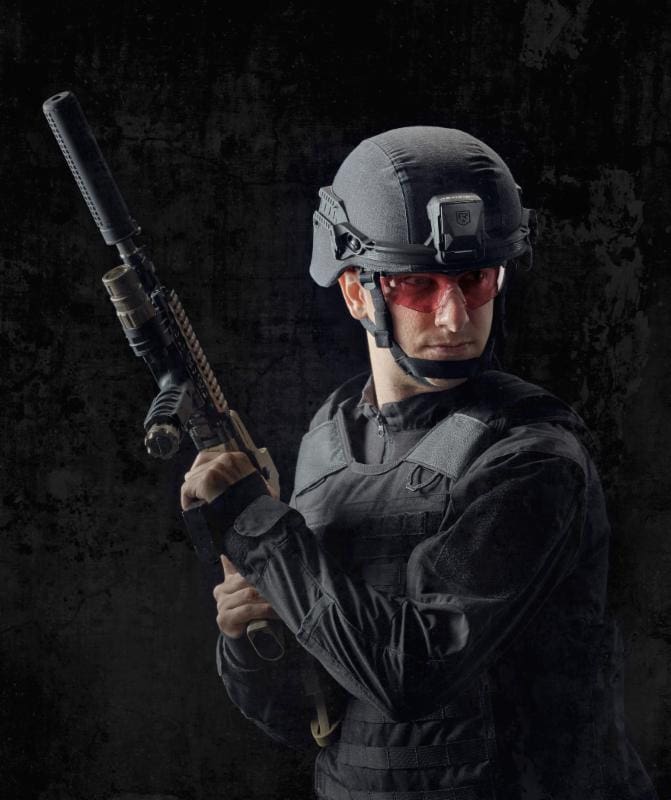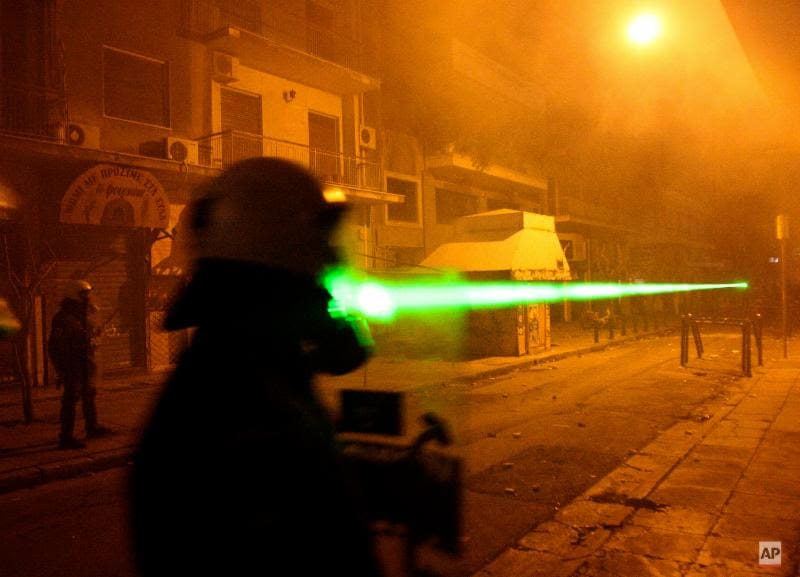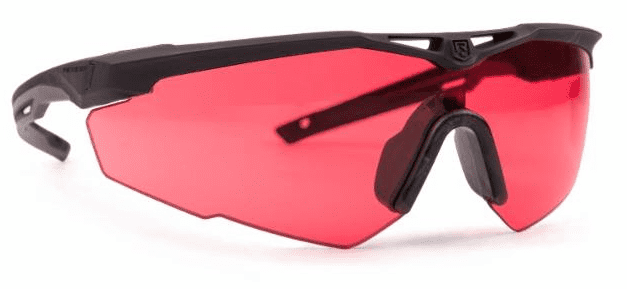
I worry about being blinded by a bad guy wielding a green laser. Not really. But I know some people who do: soldiers and fly boys. Revision’s got them covered with their new LazrBloc GF-8 laser protective lens. Its “unmatched in its combination of ballistic protective properties, green laser blockage, Near-Infrared protection, and visible light transmission, striking an optimal balance in a single, remarkably effective, integrated solution.” [Full presser after the jump.] In other words, these glasses let wearers laugh in the face of laser-equipped miscreants, before responding in kind. Just thought I’d pointer that out . . .
PRESS RELEASE:
Essex Junction, Vermont (January 18, 2016) – Revision Military, a world leader in protective eyewear solutions, has developed and patented a laser dye for a dual-band laser protective lens that blocks 99.9% of green laser energy and over 99% of the most powerful Near-Infrared (NIR) component of commercially available green lasers. Revision’s patented dye is used in the company’s new LazrBloc GF-8 Laser Protective Ballistic Lens. The LazrBloc GF-8 lens is a unique ballistic lens that blocks green laser emissions and the high-risk NIR energy that exists outside the visible spectrum. Importantly, this lens delivers greater visible light transmission and color recognition as compared to other laser lenses on the market, making GF-8 lenses ideal for day or nighttime use.

Around the globe, reports of lasers used against law enforcement officials, military personnel, and pilots have spiked in recent years. Lasers have been used against riot police in demonstrations as widespread as Canada, the U.S., Ireland, Thailand, Greece, Egypt, and Italy, to name just a few effected regions. The FAA (Federal Aviation Administration) and BALPA (British Airline Pilots’ Association), among other worldwide aviation officials and agencies, have recorded dramatic increases in malicious and inadvertent laser strikes on commercial airlines as well. According to the FAA, for 2015, laser strikes on commercial aircrafts topped 6,624 reported incidents, up from 3,894 in 2014. And, BALPA has found that half of all pilots experienced a laser attack in the past 12 months. Two trends are increasingly clear: these occurrences are on the rise and are more organized.
“We have always prided ourselves on our advanced protective eyewear solutions,” said Jim Hester, Vice President, Optics at Revision, “and this means identifying and adapting to new and more complex threats. Laser strikes are no longer just a military concern, they are an increasingly prevalent reality for many operating in the private sector. Revision is leading the way by providing an efficient and leading solution with the new LazrBloc GF-8 laser protective ballistic lenses.”

Hester notes that these new laser protective lenses, like Revision’s previous eyewear successes in ballistic spectacles, goggles, and laser protection technology, are the result of rigorous and highly-developed design, engineering, and manufacturing processes that are constantly evolving in line with market needs. Accordingly, he adds that “in this emerging industry, Revision’s LazrBloc GF-8 laser protective lens is unmatched in its combination of ballistic protective properties, green laser blockage, Near-Infrared protection, and visible light transmission, striking an optimal balance in a single, remarkably effective, integrated solution.”
Reports indicate that illuminations by handheld lasers are primarily green (91%) in color. The wavelength of most green lasers (532 nm) is close to the eye’s peak sensitivity when they are dark-adapted, and green lasers appear brighter than other laser colors of equal power output. Inexpensive and easy to obtain laser devices may not filter and/or align the optics, or can be maliciously altered, contaminating the green laser with a potentially harmful NIR component at 808 nm. The human eye is highly sensitive and strong emissions of directed light containing hazardous wavelengths can cause permanent ocular injury in an instant.
Revision’s LazrBloc GF-8 laser protective lenses are designed to block this NIR wavelength, which is undetectable by the naked eye, while still maintaining superior light transmission, color recognition, and situational awareness as compared to other dye-based laser lenses. Revision’s GF-8 lens formulation provides an interchangeable, situation-adaptable solution that can be manufactured for Revision’s StingerHawk™ Spectacle System and Exoshield™ Extreme Low-Profile Eyewear, as well as for Revision’s other Rx-compatible military spectacle and goggle lines.
Revision Military has long been at the forefront of ballistic laser protective eyewear. Hundreds of thousands of Revision’s laser protective lenses have been sold globally over the last 10 years, including to the U.S. Army, U.K. MoD, Dutch DMO, Belgium MoD, the Canadian DND, Greek MoD, Swedish MoD, the German MoD, and the South African Air Force. Seeing the increase in the malicious use of green lasers to distract or blind law enforcement, military, and aviation personnel, among others, Revision set out to design the most protective and functional laser eyewear available.
The LazrBloc GF-8 ballistic lens represents an elevated level of innovation in this field. Revision has tested the GF-8 laser lens in the company’s Research & Development laboratory and has certified many of its lenses at 3rd party testing laboratories. Revision’s in-house R&D, molding and coating facility ensures that the company is able to meet customers’ specific laser protective requirements. For additional information on this product and Revision’s capabilities, or for purchase inquires, contact [email protected].
Above: Powerful green laser illuminations have emerged as a new and widespread threat, particularly for law enforcement and military police engaged in riot control and tactical situations.
About Revision:
Revision develops and delivers purpose-built protective soldier equipment for military use worldwide. The company, which began with eyewear, has expanded to face, head and torso protection as well as energy storage and power management products, continues to develop innovative capabilities for integrated, performance-enhancing soldier systems. To that end, Revision brings together the most advanced expertise, state-of-the-art facilities and finest technical minds. Privately owned and ISO 9001:2008 certified, Revision’s operational headquarters is located in Essex Junction, Vermont, USA, with additional offices in Montreal, Canada, The UK, and Luxembourg. For more information, visit www.revisionmilitary.com, write [email protected], or call +1 802-879-7002.




Hmm. I am not convinced that blocking 99.9% of the incident light will eliminate damage to the wearer’s eyes. It all depends on the energy level emitted from lasers and how much energy it takes to damage someone’s eyes. If a typical green laser delivers 2,000 times more energy than is necessary to damage your eyes, then those lenses will not stop damage. If a typical green laser delivers 50 times more energy than is necessary to damage your eyes, then those lenses will stop damage.
Anyone know whether a 99.9% reduction of incident energy is enough?
It depends on the power of the laser and the OD rating of the eyewear. 99.9% is considered OD3 which reduces the power by a factor of 1000. That would mean that an “eye safe” expose (typically at ~1mW) would be equivalent to an unshielded 1W source. 1W is a hell of a lot of power for a hand held laser system. To give you an idea, most laser markers are in the 20W-50W range, and those straight-up burn metal.
There’s a lot more that goes into that as laser safety is a very complicated system.
The purpose of laser safety glasses is to reduce the amount of transmitted light just enough to allow the eye to close and protect itself. Laser goggles are not rated for open eye sustained use. The amount reduced over the time it takes the average eye to close is enough to prevent permanent damage to the eye from almost all non-industrial lasers. If you keep your eyes open and continue to look at a laser, not even the best eye protection will save your eyes.
Now, if you talking laser spectrum, green is so yesterday. Blue and/or Violet lasers in the 400 NM range at powers as low as 3W will cause burns right through laser goggles. These can be purchased online relatively inexpensively or created from an old blue ray player, a mini flashlight, and a bit of electronics knowledge. Just a reminder though, lasers are not toys boys and girls and I don’t advocate anyone injuring themselves or others with a laser.
That REALLY depends on the glasses. OD4 glasses in the 400nm range will dampen that 3W down to an effective 0.3mW which is about the exposure you get from the average blue LED. In our laser marker lab at my job, we have safety goggles rated OD6 in the frequencies we work with.
“The purpose of laser safety glasses is to reduce the amount of transmitted light just enough to allow the eye to close and protect itself. Laser goggles are not rated for open eye sustained use.”
That really depends on how the safety glasses were selected.
In my lab, for instance, we have a Q-switched 10-Hz Nd:YAG laser that, per shot, puts out 50 mJ at 1064nm (IR), 25 mJ at 532 NM (green) or 8 mJ at 266 nm (UV), depending on how it’s set up. Any of these modes can do immediate, permanent damage to the eye (retina, retina, cornea for the IR, vis and UV, respectively) with a single pulse.
Each pulse is around 5 ns long, so the blink reflex isn’t going to help. And since you can’t see the IR or UV, you wouldn’t blink in the first place. So, the glasses have to be capable of blocking enough light at all three wavelengths so that you could stare into the beam and not be hurt.
for the pilots!
Picture: Share! No its mine!
Nobody needs a green military style assault laser. Register, ban, confiscate.
Well it’s good this is being made.
How much?
Would be interesting to know what the light transmission of the lens are (meaning normal light). As a pilot, flying at night, I don’t normally wear shades that reduce the light in the cockpit. It’s hard enough to read with out wearing cheaters.
Importantly, this lens delivers greater visible light transmission and color recognition as compared to other laser lenses on the market, making GF-8 lenses ideal for day or nighttime use.
This is all they mention, but from some of the test products like this that I have seen, these tints are just fine at night. I would like to see this product mounted as one of the visors on our HGU-56 flight helmets. Getting hit with high powered lasers is a daily occurrence where I fly.
SOME PROTECTION IS BETTER THAN NO PROTECTION
FA HA GA HOOOOOTS!!!!
Comments are closed.